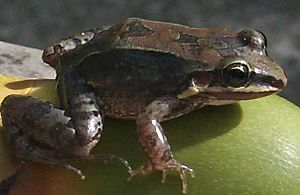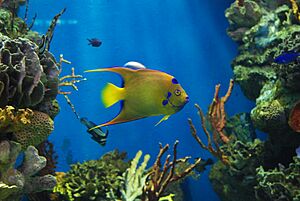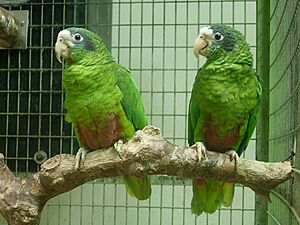Fauna of the United States Virgin Islands facts for kids
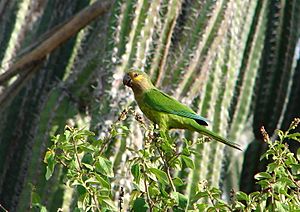
The animals of the United States Virgin Islands are super diverse! You can find 144 types of birds, 22 kinds of mammals, 302 types of fish, and 7 types of amphibians here. The wildlife in the U.S.V.I. includes many unique animals that are only found in this area, like tropical birds, fish, and land reptiles, as well as amazing sea mammals.
The only land mammals that are originally from these islands are six types of bats. These include the greater bulldog bat, Antillean fruit-eating bat, red fruit bat, Brazilian free-tailed bat, velvety free-tailed bat, and the Jamaican fruit bat. Other land mammals you might see roaming around are not native to the islands. These include white-tailed deer, small Asian mongoose, goats, feral donkeys, rats, mice, sheep, hogs, dogs, and cats.
In the ocean, you can find many types of sea mammals like whales, dolphins, orcas, and manatees. Sadly, the only type of seal that used to live here, the Caribbean monk seal, disappeared in the early 1950s. Places like Virgin Islands National Park and the Virgin Islands Coral Reef National Monument are big safe homes for many of these animals. Some animals that are currently in danger of disappearing forever include the West Indian manatee, the Virgin Islands tree boa, the Saint Croix ground lizard, and the green sea turtle.
The official bird of the U.S.V.I. is the bananaquit, which you can even see on the Seal of the United States Virgin Islands. Besides the bananaquit, there are over 140 other bird species. You might spot pelicans, parrots, parakeets, flamingos, herons, egrets, hummingbirds, sea gulls, doves, ospreys, kingfishers, and warblers. The island of Saint Croix has its own special animals, like the Saint Croix ground lizard and the Saint Croix's anole. Sadly, some animals like the Saint Croix racer and Saint Croix macaw are no longer found there.
Contents
Reptiles
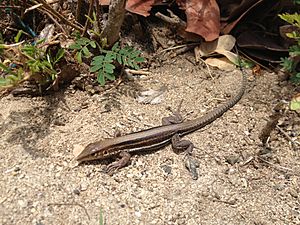
The U.S. Virgin Islands are home to some really big reptiles! One of the largest turtles in the world, the leatherback turtle, lives here. You can also find one of the biggest land lizards, the green iguana. Other types of turtles include the green and hawksbill turtles. The only turtle that doesn't live in the ocean is the red-footed tortoise.
Smaller lizards you might see include the Saint Croix's anole, Saint Croix ground lizard, Puerto Rican crested anole, St. Thomas anole, common grass anole, and the Virgin Islands worm lizard. There are also geckos like the cotton ginner and the house gecko, which locals call "woodslave." The most common lizard is the ground lizard, and you might also see tree lizards.
The Virgin Islands also have several types of non-poisonous snakes. These include the ground snake, the Virgin Islands tree boa (also called the Mona boa), and the blind snake. While green and hawksbill turtles are found all over the U.S.V.I., leatherback turtles are mostly seen near Saint Croix, especially around Sandy Point. The biggest groups of hawksbill turtles live on Buck Island and the east end of Saint Croix.
You can easily spot native lizards like anoles, ameivas, and geckos from the Cas Cay Wildlife Sanctuary and Cas Cay Island. Cas Cay is a tropical island a few miles south of Red Hook. The Cas Cay Wildlife Sanctuary is part of the Mangrove Lagoon Marine Reserve and Wildlife Sanctuary, a protected area in eastern Saint Thomas that is home to many native animals.
Amphibians
The amphibians in the U.S.V.I. include different kinds of frogs and toads. Some of these are the Virgin Islands coqui, Cuban tree frog, giant neotropical toad, common coquí, red-eyed coqui, Whistling coqui, Puerto Rican crested toad, Hispaniolan ditch frog, and the yellow mottled coqui. The yellow mottled coqui is special because it's only found in the U.S. Virgin Islands!
"Coquí" is the local name for the most common group of tree frogs found in the Virgin Islands and nearby Puerto Rico. Out of sixteen species once found in Puerto Rico, about three types disappeared in the late 1900s.
Most amphibians in the U.S.V.I. live near freshwater lakes, streams, and wet areas. Examples include the Mangrove Lagoon and Benner Bay Pond on Saint Thomas, the 500-acre Great Pond and Creque Dam on Saint Croix, and the Reef Bay Waterfall- and Pool, Francis Bay Pond, and Saltpond Bay on Saint John.
Land Mammals

Even though there are many sea mammals, the only land mammals that are truly native to the U.S.V.I. are bats. There are six different kinds of bats here: the red fig-eating bat, greater bulldog bat, Jamaican fruit-eating bat, Antillean fruit-eating bat, velvety free-tailed bat, and the Brazilian free-tailed bat. Three of these bats are protected by a special law called the Virgin Islands Endangered and Indigenous Species Act of 1990.
Many other mammals you see on the islands are not native. The white-tailed deer was brought to the islands in the 1700s. Feral hogs and dogs were introduced by native people long ago, even before Christopher Columbus arrived. Later, European settlers brought farm animals like donkeys, sheep, goats, horses, and chickens. They also accidentally brought pests like rats and the small Asian mongoose.
The small Asian mongoose has been blamed for many native animals disappearing. There are about two mongooses per acre across the U.S. Virgin Islands! The mongoose was brought in the 1800s to help control rat populations. White-tailed deer were imported for hunting in the late 1700s and again in 1937.
Marine Life
The waters around the United States Virgin Islands are full of life! They are home to many marine mammals, fish, sea turtles, corals, seabirds, and other sea creatures. More than 500 types of fish have been found in these waters. Some examples include parrotfish, hogfish, surgeon fish, butterflyfish, squirrelfish, damselfish, fairy basslet, hawkfish, spotted drum, porcupinefish, barracuda, blue chromis, snapper, Creole wrasse, hamlet, French grunt, filefish, goby, wahoo, and the Atlantic blue marlin.
The U.S.V.I. has 386 square miles of coral reefs, which is more than double the size of all the land on the islands! These reefs are super important homes for hundreds of tropical fish and coral species. Coral reefs also provide shelter for mollusks, sea urchins, sea fans, sea anemones, and sponges. Some of the corals you can find here are elkhorn coral, brain coral, pillar coral, staghorn coral, fire coral, sea whips, star coral, and finger coral. Along the reefs, you'll also see many crabs, lobsters, parrot fish, damselfish, goatfish, wrasse, triggerfish, trunkfish, trumpet fish, angelfish, squid, sea turtles, and octopus.
Among the larger sea mammals are the endangered West Indian manatee and humpback whale. There are also sixteen other types of whales and dolphins, such as the pantropical spotted dolphin, common bottlenose dolphin, Atlantic spotted dolphin, Clymene dolphin, spinner dolphin, striped dolphin, rough-toothed dolphin, Risso's dolphin, melon-headed whale, pygmy killer whale, false killer whale, and the short-finned pilot whale.
Shark species include the Caribbean reef shark, lemon shark, bull shark, tiger shark, hammerhead shark, silky shark, nurse shark, blacktip shark, and the great white shark. Many areas have large groups of tropical fish, like near Waterlemon Cay in Leinster Bay. Here you can find sergeant major, blue chromis, parrotfish, queen triggerfish, and queen angelfish. Another great place for tropical fish and birds is Buck Island, a huge protected marine area with many different corals.
The rocky Limestone Beach on Water Island is also a popular spot for scuba divers and snorkelers because of its many tropical fish. Coral World's Underwater Observatory on Saint Thomas lets you see a natural coral reef from inside! It's a 360-degree underwater view with fish like trumpetfish, grouper, squirrelfish, barracudas, seahorses, garden eels, cherubfish, moray eels, octopus, parrotfish, palometa, and mojarra.
Avifauna
The United States Virgin Islands are home to at least 144 types of birds. These include many tropical Caribbean birds, wood warblers, various seabirds, and hawks. Some tropical birds are the brown-throated parakeet, Hispaniolan parrot, and three types of hummingbirds: the green-throated carib, Antillean crested hummingbird, and Antillean mango.
Birds of prey, also called raptors, include four types of hawks: the fish hawk, marsh hawk, sharp-shinned hawk, and red-tailed hawk. There are also three types of falcons, including the American kestrel, merlin, and peregrine falcon. You might also spot two types of owls: the Puerto Rican owl and the short-eared owl.
Saba Island, located three miles south of Charlotte Amalie, has the biggest group of seabirds in the Virgin Islands Archipelago. More than 30,000 sooty terns live there, along with smaller groups of endangered roseate terns, brown noodies, bridled terns, low-crowned night herons, black-necked stilts, and yellow warblers. Another great place for bird watching, especially in winter, is Francis Bay on Saint John, which is home to over 160 bird species.


